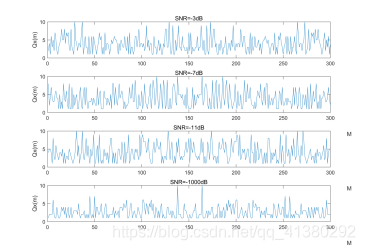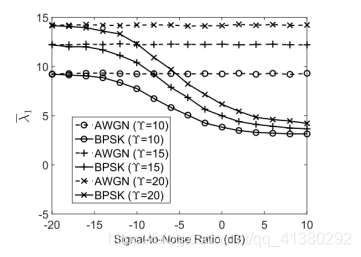Novel Robust Band-Limited Signal Detection Approach Using Graph梳理
Novel Robust Band-Limited Signal Detection Approach Using Graph
@TOC
Paper Download
原文百度云及提取码:9tok
Abstract
Abstract— In this letter, a novel graph-based adequate and concise information representation paradigm is explored. This new signal representation framework can provide a promising alternative for manifesting the essential structure of the communication signals. A typical application, namely, band-limited signal detection, can thus be carried out using our proposed new graph-based signal characterization. According to Monte Carlo simulation results, the proposed graph-based signal detection method leads to the outstanding performance, compared with other existing techniques especially when the signal-to-noise ratio is rather small.
Index Terms— Graph representation, cyclic spectral analysis,sparse signal, weak signal detection.
Implemention
==BY MYSELF==
一、信号的生成
根据文中叙述,使用BPSK进行作为实验数据,信噪比分别是-3dB、-7dB、-11dB、-$\infty$dB:
Matlab自带有pskmod函数:
function y = pskmod(x,M,varargin)%PSKMOD Phase shift keying modulation
%
% Y = PSKMOD(X,M) outputs the complex envelope of the modulation of the
% message signal X, using the phase shift keying modulation. M is the
% alphabet size and must be an integer power or 2. The message signal X
% must consist of integers between 0 and M-1. For two-dimensional
% signals, the function treats each column as 1 channel.
%
% Y = PSKMOD(X,M,INI_PHASE) specifies the desired initial phase in
% INI_PHASE. The default value of INI_PHASE is 0.
%
% Y = PSKMOD(X,M,INI_PHASE,SYMBOL_ORDER) specifies how the function
% assigns binary words to corresponding integers. If SYMBOL_ORDER is set
% to 'bin' (default), then the function uses a natural binary-coded ordering.
% If SYMBOL_ORDER is set to 'gray', then the function uses a Gray-coded
% ordering.
%
% See also PSKDEMOD, MODNORM, comm.PSKModulator.
% Copyright 1996-2013 The MathWorks, Inc.我们可以直接调用基带调制:
MPSK=2;
msg=randi([0 MPSK-1],1,nsymbol); %生成基带数据
msgmod=pskmod(msg,MPSK).'; %基带B-PSK调制然后再通过载波进行搬移:
T0=1;%符号周期
fs=50/T0;%采样率
t=0:1/fs:T0-1/fs;%时间向量
fc=2/T0; %载波频率
c=sqrt(2)*exp(1i*2*pi*fc*t);%载波信号
tx=real(msgmod*c);%载波调制然后对所得信号进行展开,方便后续计算:
tx1=reshape(tx.',1,length(msgmod)*length(c)); %tx'的每一列是一个码元代表的采样点,现展开为一行 现在所得信号是没有噪声的。我们通过SNR和信号功率计算噪声功率,并将信号和其对应的噪声相加,完成信号的模拟:
for indx=1:length(snr_dB)
rx=noisegen(tx1,snr_dB(indx),T0,fs); %加入高斯白噪声后的信号
rxy=abs(fft(rx,300));%fft
figure(1)%显示fft图像
subplot(4,1,indx)
plot(rxy);
title(['SNR=',num2str(snr_dB(indx)),'dB']);
xlabel('fft点数','position',[320 -20]);
ylabel('幅度');
end其中
noisegen函数是根据此PAPER自定义的噪声计算及添加。到此完成信号生成(变换到频域)如下:

二、计算功率谱$X(m)$,并归一化
归一化公式:
其中$X(m)$是功率谱,$\theta{max}$和$\theta{min}$是功率谱的最大值和最小值。
使用FFT计算得到功率谱$X(m)$:
rxy=abs(fft(rx,300));%fft
Ux=zeros(1,length(rxy));
%%%%%%%%%
%Normalized
%%%%%%%%%
theta_min=min(rxy);
theta_max=max(rxy);
for m=1:1:length(rxy)
Ux(m)=(rxy(m)- sita_min)/(sita_max-sita_min);
end三、量化
根据论文量化规则:
得到量化结果:
%%%%%%%%%%%
%quantization
%%%%%%%%%%%
for mm=1:1:length(Ux)
[~,r_level(mm)]=min(abs(Ux(mm)-r_set));%找到量化等级
end以此步骤画图得到Fig.1
四、构建邻接矩阵、度矩阵和拉普拉斯矩阵
根据论文可总结为:
再通过线性代数定理得到Laplacian Matrix:
其中$L$是Laplacian,$D$ 是Degree Matrix,$A$是 Adjacency Matrix
这里用一个自己定义的函数get_LaplacianMatrix来实现:
function Lx=get_LaplacianMatrix(r,Qx)
Ax_bar=zeros(r,r);
Dx_bar=zeros(r,r);
for i =1:1:length(Qx)-1
if(Qx(i)~=Qx(i+1))
Ax_bar(Qx(i),Qx(i+1))=1; %半正定矩阵
Ax_bar(Qx(i+1),Qx(i))=1;
end
end
for j=1:1:r
Dx_bar(j,j)=sum(Ax_bar(j,:));
end
Lx=Dx_bar-Ax_bar;五、计算Laplacian Matrix 的第二大特征值及其均值
求拉普拉斯矩阵Lx的特征值,记第二大特征值为$\lambda_1$。完成1000次计算,得到均值:
Lx=get_LaplacianMatrix(r,r_level);%得到laplacian 矩阵
[~,lamda]=eig(Lx);%计算特征值
[not_sort,~]=max(lamda);%提取特征值
lamda_sort=sort(not_sort);%特征值排序
lamda0(indx2)=lamda_sort(end-1);%找到第二大特征值六、判断
==根据文中理论,全联通图的$\bar{\lambda}_1$应该等于量化等级$\gamma$:
即信噪比很小或全是白噪声时,$|\lambda_1-\gamma|<\delta$。$\delta$是一个很小门限参数。==
此处定理有待证明。。。
Question
此篇文章出了一个大BUG,通过SNR计算噪声功率出现了错误。



可见,文章中的信噪比添加方式是错误的,没有考虑白噪声的功率谱。
完整代码见My Github ==Give me a star plz!==
本文作者: Joffrey-Luo Cheng
本文链接: http://lcjoffrey.top/2021/12/04/signalDetectionwithGraph/
版权声明: 本博客所有文章除特别声明外,均采用 CC BY-SA 4.0 协议 ,转载请注明出处!